You’re not running a race. You’re not standing under a blazing sun. Yet a fine layer of sweat beads along your skin, and a shiver runs down your back. That’s a cold sweat. Doctors sometimes call it diaphoresis, but labels don’t make it any less strange. It isn’t the same as sweating after a jog or a hot day outside. This is your body reacting to something inside—often stress, shock, or illness. Your skin can feel damp and clammy, even cool, while your body might still look flushed. Goosebumps aren’t unusual either.
Cold sweats can be harmless, but they can also be your body’s way of waving a red flag. Some people shrug them off; others land in the ER. Knowing the difference can be life-saving.
What Exactly Are Cold Sweats and What Does It Indicate?
Cold sweats are characterized by sudden episodes of sweating that are unrelated to external heat or physical exertion. Instead, they signify an internal response, often linked to your body's "fight or flight" mechanism. This primal response is triggered when your body perceives a threat, preparing you to either defend yourself or escape. During a cold sweat episode, you might feel a peculiar combination of being flushed and chilly simultaneously. Your skin may become clammy and cool to the touch, often appearing pale, and you might notice goosebumps.
These sweating episodes commonly manifest in specific areas of the body, such as the palms, armpits, and soles of the feet. It’s important to differentiate cold sweats from night sweats, which involve waking up in the middle of the night with your entire body, clothes, sheets, and blankets feeling damp or wet. Night sweats are limited to sleep, whereas cold sweats can occur at any time and typically don't affect the entire body in the same way. Similarly, hyperhidrosis is a distinct medical condition involving excessive and unpredictable sweating due to overactive sweat glands, whereas diaphoresis (cold sweats) is a symptom of many underlying conditions.
The underlying mechanisms that cause cold sweats often involve a loss of blood, low blood pressure, or the direct stimulation of sweat glands by adrenaline. When your body's systems are under strain, whether from physical injury, emotional distress, or an internal imbalance, cold sweats can be a prominent indicator.
A Sign of Heart Trouble

A sudden cold sweat with pressure in the chest, pain spreading into the arm, jaw, or back—this is classic heart attack territory. It can show up even without the “movie heart attack” crushing chest pain. Shortness of breath, nausea, dizziness, or a bluish tinge to lips or fingers makes it even more urgent. This is the sort of combination you don’t wait for. Call emergency services.
A Sign of Infection or Sepsis
Fever breaking? You might get a burst of sweat that feels cool on the skin. That’s one thing. But when cold sweats arrive with pale skin, rapid breathing, chills, confusion, or limbs that feel cold and look blotchy, it could mean an infection has moved into the bloodstream. That’s sepsis. Left untreated, it can be fatal. Timing matters here—minutes can count.
A Sign of Low Blood Sugar
Shaky hands, a pounding heart, maybe a bit of irritability, and that clammy skin—low glucose can hit like that. It’s especially common for people with diabetes after insulin or certain medications, but it can happen to anyone if the gap between meals stretches too long. A quick snack can help, but recurring episodes mean you need to get it checked.
A Sign of Shock
Shock isn’t just surprise—it’s a medical state where blood flow to vital organs drops dangerously low. It can follow major injuries, allergic reactions, severe bleeding, even certain infections. Cold sweats in shock are often joined by a weak pulse, dizziness, fast breathing, and sometimes confusion.
While waiting for help, lying flat with feet slightly raised can preserve blood flow.
A Sign of Severe Pain
Not every painful episode brings a cold sweat, but some do. Kidney stones, gallbladder attacks, fractures—the body sometimes reacts to intense pain with an adrenaline surge, and that can make the skin clammy. Pain accompanied by cold sweats, especially if sudden and intense, warrants attention.
A Sign of Anxiety or Panic
When the brain thinks you’re in danger, your body reacts whether or not the threat is real. The fight-or-flight system speeds up your heart, sharpens breathing, and can leave you damp and chilled. The difference here is that the episode often passes once the anxiety subsides. If it’s frequent, it might point to a disorder worth treating.
A Sign of Breathing Problems
Cold sweats can appear when the body isn’t getting enough oxygen. Severe asthma attacks, COPD flare-ups, allergic reactions, even lung injuries can bring them on. Watch for wheezing, trouble speaking, or confusion—those mean you need help right away.
A Sign of Withdrawal
Coming off certain drugs or alcohol can send the body through a storm of symptoms: mood changes, tremors, nausea, restless sleep, and yes, cold sweats. For heavy users, withdrawal without medical oversight can be dangerous.
Other Possible Signs
Sometimes cold sweats point to hormonal changes like menopause or thyroid disease. They can accompany certain cancers, especially lymphomas, or appear in dehydration, vertigo, or after a sudden drop in blood pressure. Medications—from antidepressants to opioids—list sweating among possible side effects.
When to Act
Cold sweats on their own aren’t always cause for panic. They can follow a tough workout, a stressful conversation, or even a heavy meal if your body’s chemistry swings a bit. But it’s the company they keep that matters. If you notice them alongside chest discomfort, pain moving into the arm or jaw, sudden trouble catching your breath, or dizziness that makes you feel unsteady, you’re in territory where waiting it out could be risky.
Certain signs mean you should call for help right away: confusion that comes on quickly, lips or fingertips turning blue, a pulse that feels weak or irregular, or breathing that becomes fast and labored. Cold sweats paired with those symptoms can be your body’s version of an alarm bell.
If the episode follows an injury, blood loss, or an allergic reaction, don’t try to “see if it passes.” Conditions like shock and sepsis can progress faster than you think, and they’re far easier to treat early. Even in less dramatic situations, if cold sweats keep showing up without a clear reason, it’s worth having a professional look into it. A simple conversation with your doctor, backed by details about when they occur and what else you felt, can often point toward a cause and a solution.
The Bottom Line
A cold sweat is rarely random. It’s a signal; sometimes subtle, sometimes screaming that something’s going on inside. Knowing what it can be a sign of means you’re better prepared to act when it matters. And if you’re ever in doubt, get checked. It’s one of the few situations in life where overreacting is safer than the alternative.







